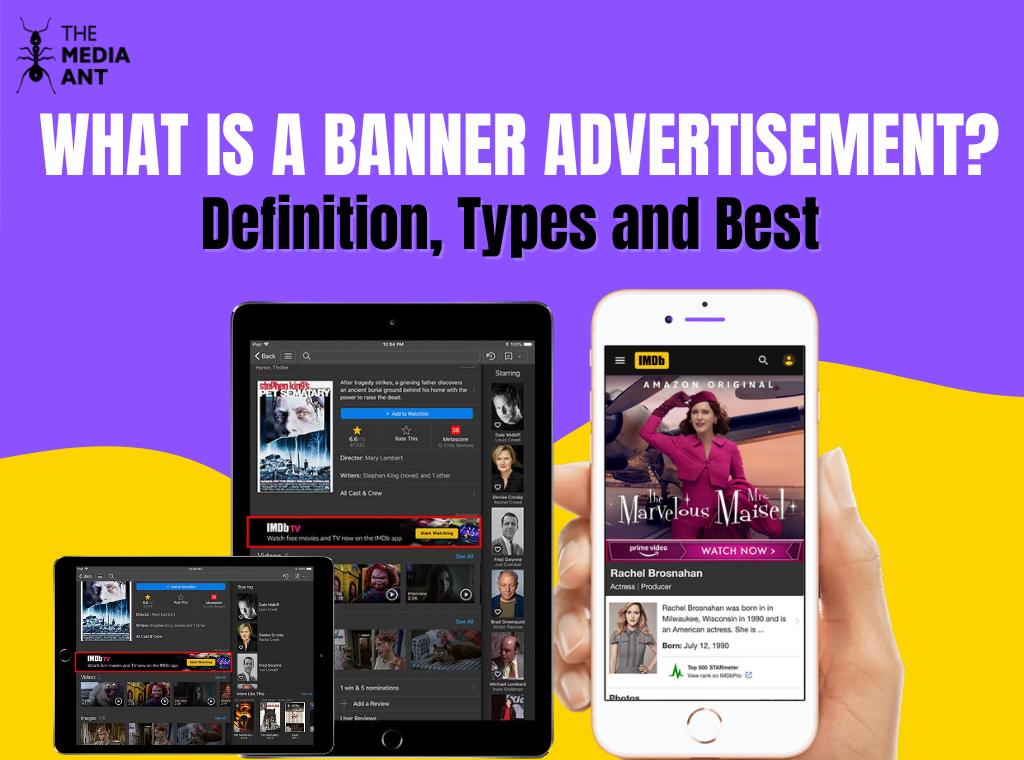Banner advertisement is a form of online advertising that utilizes graphical images or multimedia elements displayed on web pages to promote a product, service, or brand. These ads typically appear at the top, bottom, or sides of a webpage and aim to capture the attention of visitors and drive them to take a specific action, such as clicking through to a website or making a purchase.
In today’s digital age, banner advertisements play a significant role in the marketing strategies of businesses across various industries. With their ability to reach a wide audience and generate leads, banner ads have become a staple in the online advertising landscape.
What is Banner Advertisement
Banner advertisement is a form of online advertising that utilizes graphical images or multimedia elements displayed on web pages to promote a product, service, or brand. These ads typically appear at the top, bottom, or sides of a webpage and aim to capture the attention of visitors and drive them to take a specific action, such as clicking through to a website or making a purchase.
In today’s digital age, banner advertisements play a significant role in the marketing strategies of businesses across various industries. With their ability to reach a wide audience and generate leads, banner ads have become a staple in the online advertising landscape.
What are the types of Banner Ads?
Banner ads come in various types, each designed to suit different goals and preferences of advertisers. Here are some common types of banner ads:
1. Static Banner Ads
These are the simplest form of banner ads, consisting of a single static image without any animation or interactive elements. Static banner ads are cost-effective and easy to create but may have lower engagement rates compared to more dynamic formats.
2. Animated Banner Ads
Animated banner ads incorporate movement or animation to capture the viewer’s attention. They can include simple animations like flashing text or more complex animations to showcase products or services. Animated banner ads tend to have higher engagement rates than static ads but require more design expertise.
3. Interactive Banner Ads
Interactive banner ads allow users to engage with the ad by clicking, hovering, or dragging elements within the banner. These ads can include interactive games, quizzes, or surveys, providing users with a more immersive experience and increasing engagement.
4. Rich Media Banner Ads
Rich media banner ads combine various elements such as text, images, video, audio, and interactive features to create highly engaging and visually appealing advertisements. These ads often offer a more interactive and dynamic experience for users, leading to higher click-through rates and conversions.
5. Expandable Banner Ads
Expandable banner ads start as a standard-sized banner but expand or reveal additional content when clicked or hovered over by the user. These ads allow advertisers to deliver more information or creative content without taking up excessive space on the webpage.
6. Floating Banner Ads
Floating banner ads appear on the web page and move or “float” around as the user scrolls through the content. These ads typically stay within the user’s field of view, ensuring maximum visibility and engagement.
7. Video Banner Ads
Video banner ads incorporate video content within the banner space. They can autoplay or require user interaction to play and are effective for capturing attention and conveying complex messages or storytelling.
8. Native Banner Ads
Native banner ads blend seamlessly with the content and design of the webpage, resembling editorial content rather than traditional advertisements. These ads are less intrusive and can improve user experience while still achieving advertising objectives.
By choosing the right type of banner ad based on their objectives, target audience, and budget, advertisers can effectively engage users and drive desired actions.
How Do Banner Ads Work?
Banner ads work by displaying graphical or multimedia advertisements on web pages that are part of a network where advertisers have purchased ad space. Here’s how banner ads typically work:
1. Ad Placement
Advertisers purchase ad space on websites or within mobile apps that are part of an ad network. This can be done directly with individual publishers or through ad networks that aggregate ad space across multiple websites.
2. Ad Serving
When a user visits a webpage or uses a mobile app that contains banner ad placements, the ad network’s ad server identifies available ad slots and selects the most relevant ad to display based on factors like the user’s demographics, browsing history, and the content of the webpage.
3. Ad Display
The selected banner ad is then dynamically inserted into the webpage or app interface, appearing as a graphical or multimedia element alongside the content. Banner ads are typically displayed at the top, bottom, or sides of the webpage or app interface for maximum visibility.
4. User Interaction
Users can interact with banner ads by clicking on them, hovering over them, or engaging with any interactive elements they may contain. Clicking on a banner ad typically redirects the user to the advertiser’s landing page or website, where they can learn more about the advertised product or service or take a desired action, such as making a purchase or signing up for a newsletter.
5. Tracking and Measurement
Ad networks and advertisers track the performance of banner ads using metrics such as impressions, clicks, click-through rate (CTR), conversions, and return on investment (ROI). This data allows advertisers to assess the effectiveness of their ad campaigns, optimize their targeting and creative strategies, and make informed decisions about future advertising efforts.
Overall, banner ads work by leveraging ad space on websites and mobile apps to reach target audiences with visually engaging advertisements, driving user engagement and ultimately achieving the advertiser’s marketing objectives.
Most Popular Banner Ads Formats and Sizes
1. Leaderboard (728×90 pixels)
Positioned prominently at the top of webpages, ideal for brand awareness and important announcements due to its visibility.
2. Medium Rectangle (300×250 pixels)
Versatile and commonly placed within content, suitable for showcasing products, services, and promotions without being overly intrusive.
3. Skyscraper (160×600 pixels or 120×600 pixels)
Tall and narrow format often positioned on the side of webpages, effective for vertical content like lists or product features, grabbing attention while not interfering with main content.
4. Mobile Banner (320×50 pixels or 320×100 pixels)
Tailored for smaller screens on mobile devices, providing a non-intrusive yet effective way to engage mobile users with concise messaging and visuals.
5. Interstitial Ad (Full-screen)
Offers a full-screen immersive experience, commonly used in mobile apps during transitions or breaks, providing high visibility and engagement opportunities for advertisers.
Best Practices for Creating Banner Ads
1. Focus on Visual Impact and Branding Consistency
- Design visually appealing banner ads that align with your brand’s aesthetic and messaging. Consistency in branding helps build brand recognition and trust.
- Use high-quality images or graphics that grab attention and evoke emotions relevant to your brand or the advertised product/service.
- Incorporate your brand’s logo, colors, and fonts to ensure coherence across all marketing materials and reinforce brand identity.
2. Craft Compelling and Clear Messaging
- Keep the message concise, clear, and focused on a single, compelling value proposition or call-to-action (CTA).
- Use persuasive language that resonates with your target audience and highlights the benefits of engaging with your ad or product.
- Make sure the text is easily readable, even at smaller sizes, and avoid cluttering the ad with too much information.
3. Optimize for User Experience and Mobile Responsiveness
- Design banner ads with a responsive layout that adapts seamlessly to various screen sizes, including mobile devices.
- Ensure that interactive elements, such as buttons or clickable areas, are large enough and easy to tap on touchscreen devices.
- Minimize load times by optimizing file sizes and using appropriate image formats to enhance user experience, especially on slower internet connections or mobile networks.
4. Incorporate Strong Calls-to-Action (CTAs)
- Use clear, action-oriented CTAs that prompt users to take the desired action, such as “Shop Now,” “Learn More,” or “Sign Up.”
- Position the CTA prominently within the ad and use contrasting colors or visual cues to make it stand out.
- Create a sense of urgency or incentivize action by including time-limited offers or exclusive deals in your CTA.
5. Test, Iterate, and Optimize
- Implement A/B testing to experiment with different creative elements, such as imagery, messaging, CTAs, and colors, to identify what resonates best with your audience.
- Track key performance metrics, including click-through rates (CTR), conversion rates, and engagement metrics, to measure the effectiveness of your banner ads.
- Analyze the data collected from tests and campaigns to gain insights into user behavior and preferences, then use these insights to refine your banner ad strategies and optimize future campaigns for better results.
Examples of Banner Advertisement
1. Celebration Time! (Big Bazaar – Hypermarket Chain)
Imagine this banner on a busy street in Bengaluru: A vibrant image showcases a family gathered around a table laden with delicious Indian sweets and snacks. The Big Bazaar logo is prominently displayed with the text “Celebration Time! Big Shopping, Bigger Savings on Holi Essentials. Upto 50% Off!” in Hindi and English. This ad leverages the festive spirit (assuming it’s around Holi), uses relatable imagery, and highlights savings on relevant products in both local and national languages.
2. mAh Bechta hai Confidence! (Noise – Audio Brand)
This banner targets the tech-savvy crowd. A sleek pair of Noise wireless earbuds rests against a backdrop of vibrant city lights. The Noise logo stands out with the tagline “mAh Bechta hai Confidence!” (Hindi for “Power Sells Confidence!”) in bold letters. Text below details extended battery life and a special discount. This ad uses a trendy product in an urban setting, connects with a young audience through a local language tagline, and highlights a key product feature.
3. Start Your Dream Bike Journey (Bajaj – Motorcycle Brand)
This banner targets young, adventurous audiences: A powerful Bajaj motorcycle cruises down a scenic mountain road with a breathtaking view. The Bajaj logo is displayed with the tagline “Start Your Dream Bike Journey. Book a Test Ride Today!” This ad uses an aspirational image and tagline to connect with potential riders, mentions the brand name, and includes a clear call to action.
Conclusion
In conclusion, banner advertisement remains a powerful tool for businesses looking to increase their online visibility and drive conversions. By understanding the different types of banner ads available and implementing best practices such as compelling visuals, targeted messaging, and strategic placement, advertisers can maximize the effectiveness of their campaigns.
As technology continues to evolve, so too will the landscape of banner advertising. By staying informed of emerging trends and adapting their strategies accordingly, businesses can continue to leverage banner ads as a valuable asset in their marketing arsenal, ensuring they stay ahead in the competitive digital marketplace.
FAQs on Banner Advertisement
1. How do you write a banner ad?
To write a banner ad, craft a concise message focusing on a single benefit or call-to-action. Use persuasive language, incorporate your brand’s identity, and include a strong CTA. Keep it visually appealing, clear, and optimized for mobile responsiveness to drive clicks and conversions.
2. Why use banner ads?
Banner ads offer wide-reaching visibility across websites and apps, effectively targeting specific audiences. They drive brand awareness, website traffic, and conversions. With diverse formats, easy scalability, and measurable results, banner ads remain a cost-effective tool for digital advertising strategies.
3. What size is a banner ad?
Banner ads come in various sizes, including common dimensions like 728×90 pixels for leaderboards, 300×250 pixels for medium rectangles, and 160×600 pixels for skyscrapers. Mobile banner ads typically range from 320×50 pixels to 320×100 pixels.
How successful are banner ads?
Banner ads’ success varies based on factors like targeting, design, and placement. While they offer broad visibility, their effectiveness is measured by metrics such as click-through rates (CTR), conversions, and return on investment (ROI), which can vary widely based on campaign optimization.





